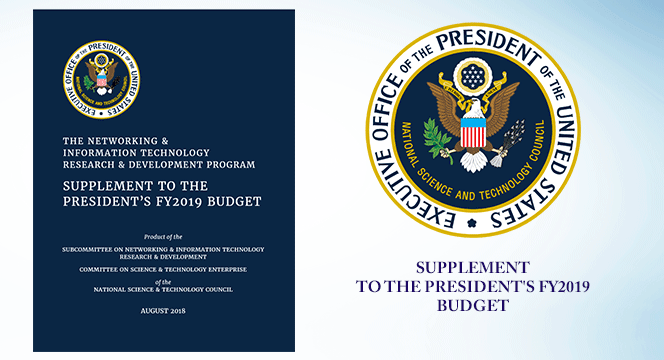View Full Text: FY2019-NITRD-Supplement.pdf
Information technology (IT) is perhaps the most broadly transformative technology ever invented, with impacts on defense, security, energy, healthcare, and more. Innovation in IT continually enables pivotal new applications that advance U.S. national priorities and Federal agency missions. For 27 years, the Networking and Information Technology Research and Development (NITRD) Program has been the Nation’s primary source of federally funded research and development (R&D) on networking and information technology. The Program maximizes coordination of Federal IT R&D to optimize Federal investments that support agency missions and contribute to the public good.
The NITRD Program is tasked with providing the IT R&D foundations for assuring continued U.S. leadership in science and technology, supporting investments that develop tools and technologies with the potential to open new areas of discovery, and increasing government accountability and efficiency with advanced IT. The NITRD Program provides a framework and mechanisms to maximize coordination among the many Federal agencies that support R&D in advanced information technologies and report IT research budgets in this NITRD Supplement to the President’s fiscal year (FY) 2019 Budget. As required by legislation, this NITRD Supplement details the NITRD Program’s FY2019 requested budgets by participating agency and Program Component Area (PCA) to meet Program goals and national priorities for state-of-the-art IT and software R&D.
Technologies developed from NITRD Program research activities continue to improve the lives of all Americans. The following examples, distilled from this NITRD Supplement, illustrate how the Federal IT and networking R&D coordinated by the NITRD Program advance national priorities, as described in the FY2019 Administration R&D Budget Priorities memorandum. Federal R&D in high-capability computing is advancing state-of-the-art, dual-use technologies and tools to defeat emerging threats on the physical and cyber battlefields, including applications ranging from military platform analysis to artificial intelligence; supporting exascale and quantum computing that accelerate innovation and will shorten time to market; and paving the way to modernizing and effectively managing research infrastructure, including leading-edge supercomputing facilities.
Cybersecurity R&D is developing capabilities to provide the U.S. military an advantage by developing effective cyber-defensive technologies and improved cyber-situational awareness. Participating agencies are also strengthening national security by developing cybersecurity capabilities that improve the resiliency of cyber and cyber-physical systems, protect national assets against cyber attacks, enable the Nation’s critical infrastructure to withstand cyber incidents, and allow for timely and appropriate cyber responses.
Federal intelligent robotics and autonomous systems R&D enables teams of autonomous vehicles for disaster response and first responder safety, intelligent and collaborative robots that strengthen U.S. manufacturing competitiveness, and intelligent robotics to enhance surgery and support independent living.
Agencies active in networking technology R&D are developing, standardizing, and deploying technologies that enhance infrastructure security, protect end-to-end communications, provide networking support, provide control and situational awareness capabilities, support cyber defense at scale, and enable future networked information systems.
Federal R&D in computing-enabled networked physical systems is helping the Nation realize the smart electric grid of the future by enabling development of real-time, adaptive, and interoperable electric grid cyber-physical systems that increase grid reliability, resilience, and security.
Other NITRD Program R&D and coordination activities include work to provide trust and resilience in software that enables it to recover from attacks in real time; innovation in reusable community-based big data analytics tools and open datasets that promote the fusion of ideas to address grand-challenge problems in science and society; video analytics such as face-in-video recognition for law-enforcement and anti-terrorism operations; medical device interoperability to enable safer and data-informed medical care; innovative interfaces for people to interact with energy systems to support more efficient and effective use of energy; privacy-enhancing technologies for securely sharing personal health data; and spectrum-sharing capabilities and spectrum-maneuverable communications for battlefield applications.
All NITRD agencies are focused on developing a future-focused workforce through a variety of programs, including partnerships that expand computer science, math, and engineering education at all grade levels, and activities that are building a robust ecosystem of cybersecurity education, training, and workforce development to ensure sufficient talent to meet growing IT security threats.


